RIOULT Dance New York premieres “Iphigenia” at the Joyce Theater, June 5 through 9.
Pascal Rioult was an important member of Martha Graham’s company during the last part of her life. Three years after her death in 1991, he founded RIOULT Dance New York and built it into a prospering entity, with performances in the U.S. and abroad, a wide-ranging outreach program to introduce children and adults to modern dance, and year-round health insurance for his dancers. His choreography has been warmly received, and the audience for the company’s opening night at the Joyce Theater applauded enthusiastically.
In the past, Rioult has boldly tackled musical masterpieces. The New York Times declared that his 2003 Black Diamond, set to Igor Stravinsky’s Duo Concertante, could hold its own against George Balanchine’s duet utilizing the same music. Subsequent reviews have been less admiring of Rioult’s approach to great music of the past, and he may have been reconsidering this aspect of his work. Although two pieces on the Joyce program, Prelude to Night and Bolero (both 2002), derive from his interest in Maurice Ravel, the other two, On Distant Shores (2011) and Iphigenia (a world premiere developed at the Kaatsbaan International Dance Center), were choreographed to commissioned scores by prominent contemporary composers. Michael Torke wrote the score for Iphigenia, and Aaron Jay Kernis created the music for On Distant Shores.
Merce Cunningham, Erick Hawkins, and Paul Taylor all danced with Graham’s company, and you’d never guess that from looking at their work (well, maybe one or two favorite Taylor steps do hark back. . .). Few contemporary choreographers who were once associated with her still honor her themes, her structures, and aspects of her style. Rioult has struck out in other directions in a number of his works, but the Joyce program reveals a strong Graham influence.
As is usual with his presentations, the four dances shown have interesting sets and well-designed costumes, and the members of his company (11 plus one apprentice) perform the pieces with skill and dedication. But the programming struck me as strange. For one thing, the total performing time was slightly over 90 minutes; two intermissions and one fairly lengthy pause made for a very long evening. For another, three of the works focused on a dilemma prominent in Graham’s oeuvre: a woman in torment—either from inner demons or outside forces beyond her control. Two of these occur in Graham’s favorite mythic landscape, that of ancient Greece, and employ the strategies of dream and flashback that she pioneered. In terms of psychological nuance and dramatic insight, this is territory that Graham staked out, and competitors, or those paying homage, enter it at their risk.
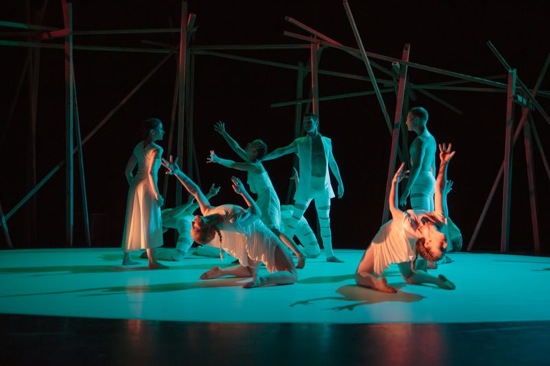
L to R: Clytemnestra (Marianna Tsartolia), Iphigenia (Jane Sato), Agamemnon (Brian Flynn), and Achilles (Jere Hunt) in Pascal Rioult’s Iphigenia. Photo: Eric Bandiero
For Iphigenia, Harry Feiner designed a circular white floor and a set of slim wooden rails that could evoke a palace or a forest or a thicket of ship’s masts. In any case, the irregular structure provides a place for characters to lurk when not actively involved in the plot. Torke’s score for clarinet, bassoon, French horn, cello, and bass is a masterful mingling of tough, 20th-century dissonances with lush, romantic passage, and (a special treat) it’s played live by Camerata New York, conducted by Richard Owen.
Rioult has pared Euripides’s tragedy Iphigenia in Aulis down to its four essential characters: Agamemnon, King of Mycenae; his wife, Clytemnestra; his eldest daughter, Iphigenia; and the great warrior Achilles. Three men and three women act as the chorus. The goddess Artemis, angered, has becalmed the Greek fleet that’s bound for Troy to recover the kidnapped Helen and generally wreak havoc. She can be appeased if Agamemnon sacrifices his child. Clytemnestra and Iphigenia journey to Aulis, thinking the girl has been summoned to marry Achilles.
Rioult’s work begins with a brief foreshadowing of its ending (Iphigenia held aloft, crumpling into death), then flashes back to her happily at play, and works forward. The actress Jacqueline Chambord appears from time to time to speak a few relevant lines from the play. Jane Sato, as Iphigenia, watched approvingly by Mariana Tsartolia as Clytemnestra, has a long opening solo which Sato performs excellently—frolicking around the space, her body pliant, her arms scooping up air. But the solo goes on for what seems like a very long time. Iphigenia keeps revealing herself as charming, innocent, and a bit roguish well after the point has been made, and the choreography hints at no other aspects of her character.
The male characters don’t walk; they stalk, their bare chests thrust out. They lift proud Agamemnon (Brian Flynn), their leader, and show their prowess. One unexpected, enigmatic, but satisfying moment occurs when they cluster around him, and he pushes their heads down one by one. The three women of the chorus have less to express. Rioult shows us in brief the betrothal, the ensuing tender duet between Iphigenia and Achilles (Jere Hunt), her pleadings with her obdurate father, and Clytemnestra’s rage against her husband. Iphigenia dances alone and troubled, echoing some of her earlier movements. Achilles, Agamemnon, and Clytemnestra tangle. The opening is reprised in part. Torke’s sectional music enhances all the mood changes.
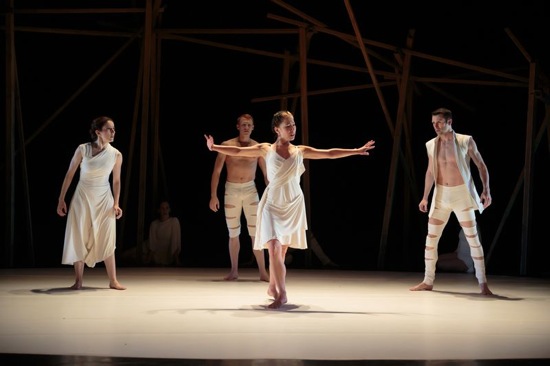
Iphigenia stops the quarrel. Jane Sato (foreground) and (L to R) Marianna Tsartolia, Jere Hunt, and Brian Flynn. Photo: Eric Bandiero
But what Rioult can’t show us is that this is more than a family quarrel. The war against Troy is at stake; the army needs Achilles to stop defending his bride. When Rioult’s Iphigenia decides to accept her fate and even rejoice in it, it seems as if she’s doing it out of exasperation, just to stop a fight among her parents and her bethrothed. And from that climactic point until her exit into darkness, no further revelations occur, and the action becomes murky. Although Sato imbues the central character with warmth, and the other dancers do their best, it’s like watching a Greek tragedy performed by cardboard figures.
Rioult has subtitled On Distant Shores “. . .a redemption fantasy.” This time the heroine (Charis Haines) is Helen of Troy, and the choreographer refers to Euripides’ play of the same name, in which, according to one legend, the gods, for various tricky reasons, have substituted a likeness of Helen and stashed the real beauty in Egypt. The dance begins with four men (Flynn, Hunt Josiah Guitian, and Holt Walborn) lounging near a backdrop onto which lighting designer David Finley has projected a luminous, rippling sea. Recorded voices murmur in Kernis’s score.
The real Helen, it seems, is imagining the havoc she has caused and expressing her pain and perhaps guilt. Dancing alone, while the men lie supine, she twists into a back fall over and over again. The four, who seem to stand for all the fallen at Troy, rise briefly into slow-motion fights and silent howls. Like a nurse prowling the battlefield, Haines pulls one (Hunt) up and into a duet, then another (Flynn, I believe). Walborn walks her as if she were a doll. But all sink back to the floor in the end.
The heroine of Prelude to Night journeys through her own imagination and nightmares to excerpts from Ravel’s Rapsodie Espagnole (castanets and all) and his Alborada del Gracioso. This is the most dramatic piece in terms of movement imagery. It’s also confusing at times. As it begins, a woman in a red dress (Penélope González at the the performance I saw) is yanked about by four men in white (Iphigenia all over again), after which she agonizes in a pool of light in front of a row of white pillars (another set by Feiner). They attack her again, and, in a familiar, effective theatrical device, she slips out of their grasp, leaving them frozen, then returns and fits herself back into their grasp. At times when she holds their hands, she seems to melt a little.
González takes her hair down and exchanges her red dress for a white one that’s brought to her. Two other women appear in identical red dresses (costumes by Russ Volger) and are then led away (am I seeing things? Does Rioult have a thing about doubles?). This section is the protagonist’s nightmare. Sato enters, borne on the shoulders of a masked man, clawing her hands witchily. Magically, the white pillars have turned rusty and ragged-topped. Three masked couples plus one man (all in minimal black attire) savage her. The men’s masks have little elephant trunks instead of noses. She really has a time of it. Her legs are pulled apart; two men grab her, one of them gnaws on her arm.
In the final section, the pillars are white again, the men wear black coats over white outfits, the music and the lights are brighter. Nevertheless, legs together, arms spread, Gonzalez is rotated like a human crucifix. Things don’t seem to have improved much for her. Of all the three women that Rioult has made suffer in these three dances, she’s the most passive. And what has she achieved in the way of an epiphany? Not much.
After all this female agony, Bolero comes as a relief. Rioult exits his Graham mode to approach the familiar relentless score as a mechanistic display that speeds up and becomes more complex as it develops along with the music. The dancers, spread out in lines, make stiff, angular gestures against Feiner’s backdrop of geometrical architecture. A single woman slowly unfolds one leg to the side and balances a second before rejoining them. A man echoes that move. The patterns keep going and shifting internally, sometimes freezing for a few seconds.
As the people begin to change places, to move into new formations (lines, circles), to pair up, to strike out in space, to cluster. you occasionally see what’s been missing in the other three dances: counterpoint as an antidote to unison. It’s very welcome, as is the fierce, no-nonsense build of the dance, and the image of the dancers as equally skilled workers rather than impotent, beleaguered women and the muscular men who dominate them.

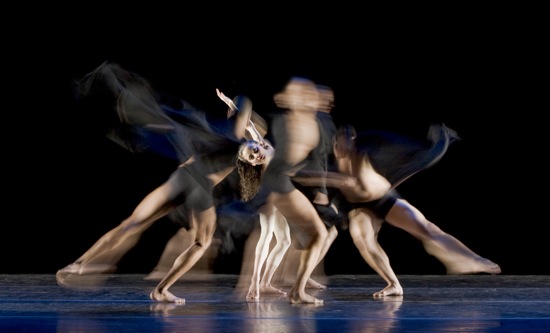
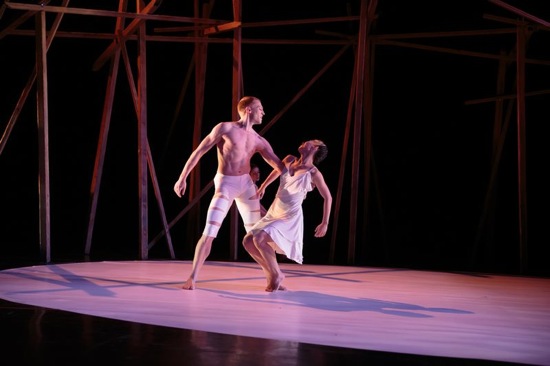
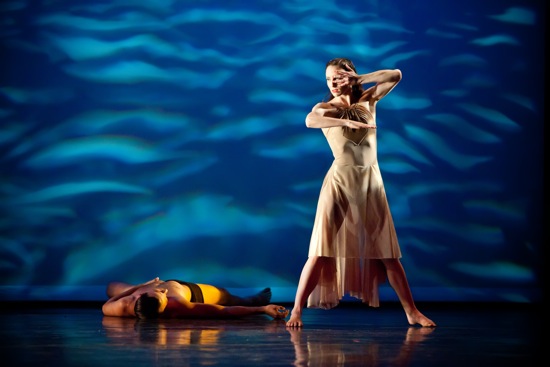
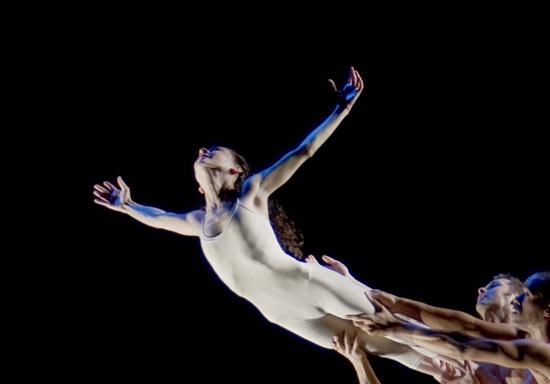
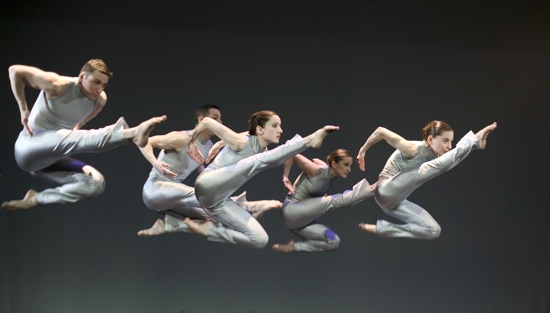
I bumped into your website quite unexpectedly. After reading this I don’t regret at all!